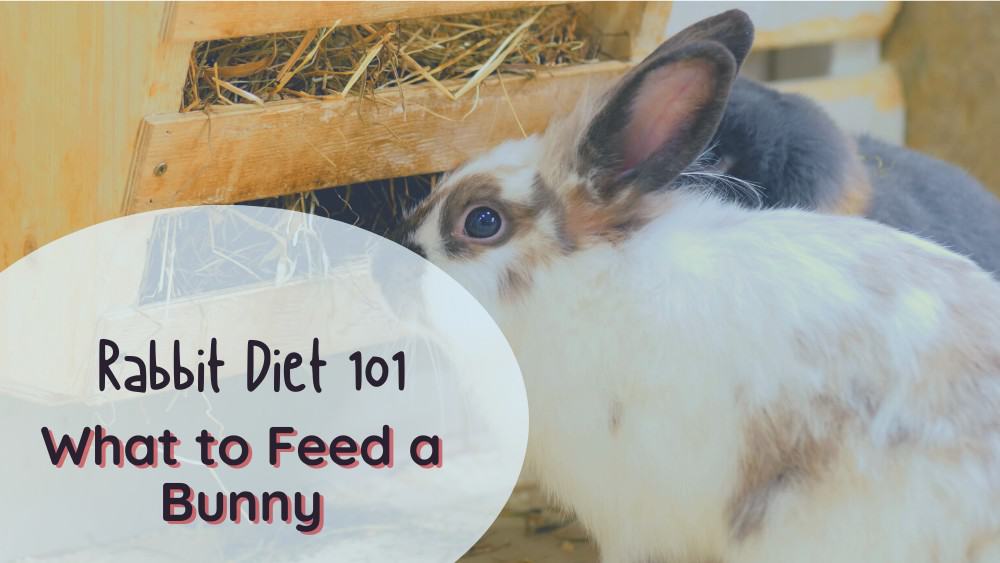Rabbits are grazers that love eating different kinds of food, but like all of us, their preferences don’t always match up to what’s healthy for them! Unfortunately, some of those less-healthy preferences are reflected in commercial rabbit foods. The result? An estimated one-in-three pet rabbits is overweight, while digestive disorders and heart disease are major causes of rabbit mortality worldwide.
There’s no doubt that providing the right diet will keep your pet healthy and happy, but sometimes it can be hard to find unbiased information.
So I’ve put together this guide to give you evidence-based, veterinary-approved rabbit diet information, exactly as I would recommend for my patients.
In this article, we’ll cover:
- What to feed rabbits, whether adults or kittens
- Popular foods that rabbits eat, and their benefits or down-sides
- Tips on how to change your rabbit’s diet
- Frequently asked questions
What Can Rabbits Eat?
Pet rabbits should eat a balanced diet comprising grass and hay (around 85%), leafy greens and fresh vegetables (10%), and limited fruits, along with a handful of rabbit pellets daily. Rabbits are very efficient at processing food, but their digestive systems are also diet-sensitive, so diet changes must be made slowly.
This article does not cover foods that rabbits cannot eat. We have a separate article on that. You can read it here: 18 Foods You Should Never Feed Your Rabbit.
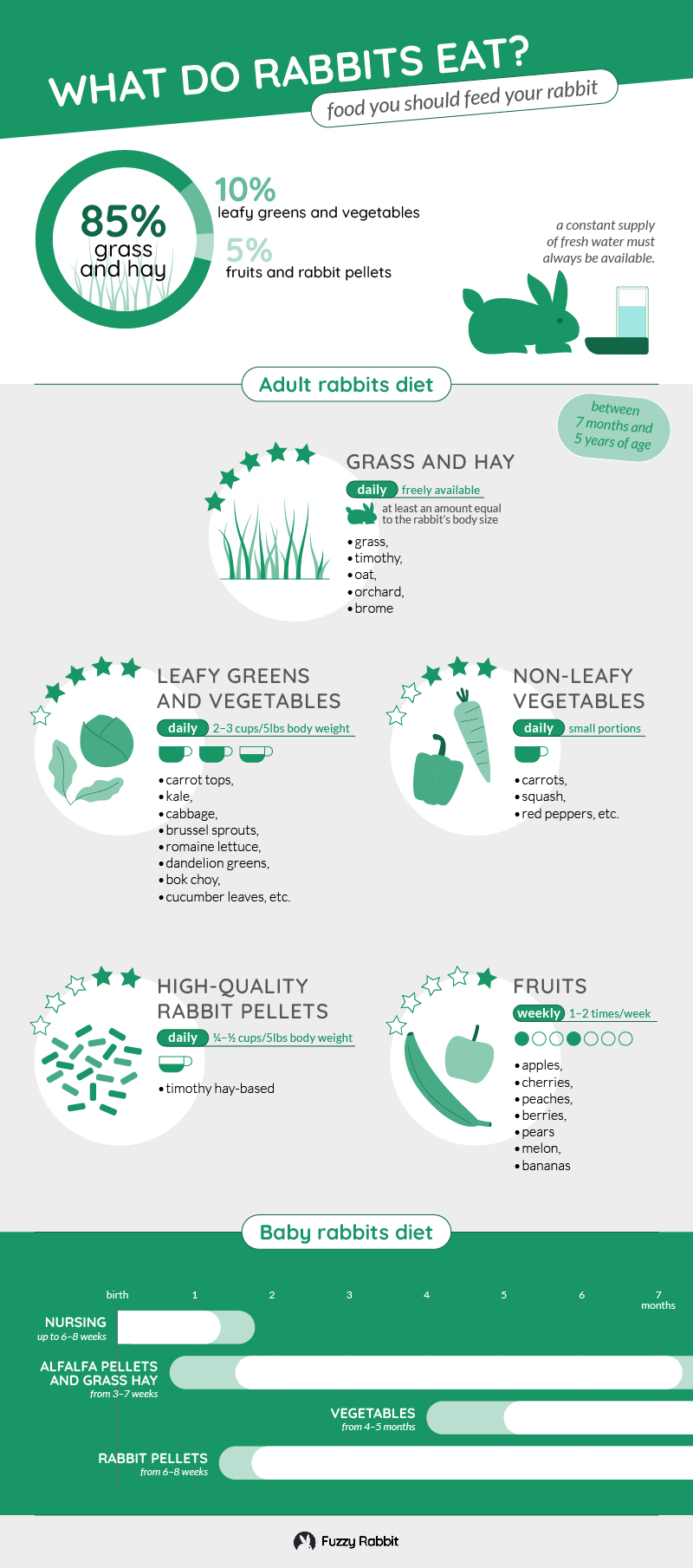
Share this infographic on your site!
<a href="https://www.fuzzy-rabbit.com/what-do-rabbits-eat/"><img style="width:100%;" src="https://www.fuzzy-rabbit.com/wp-content/uploads/2023/05/What-do-rabbits-eat-infographic.jpg"></a><br>Infographic Created By <a href="https://www.fuzzy-rabbit.com/">Fuzzy Rabbit</a>The Ideal Rabbit Diet
A rabbit’s diet should mimic its natural grass-based diet in the wild. This translates to a high-fiber diet consisting of unlimited good quality hay such as timothy, orchard, brome, or oat hay. You should supplement it with leafy green vegetables and a handful of pellets or nuggets each day.
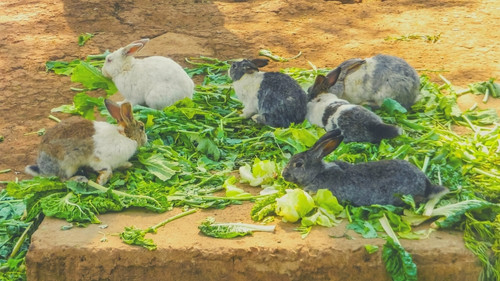
This high-fiber diet is essential for keeping a rabbit’s teeth at the right length. This is vital as rabbit teeth never stop growing, and need to be worn down every day to stay at the right length. When teeth get overgrown, everyday activities like eating and grooming become difficult.
If you want to offer treats, use natural and healthy options like carrot slices rather than yogurt or chocolate drops. A constant supply of fresh water must always be available.
Diet for Adult Rabbits
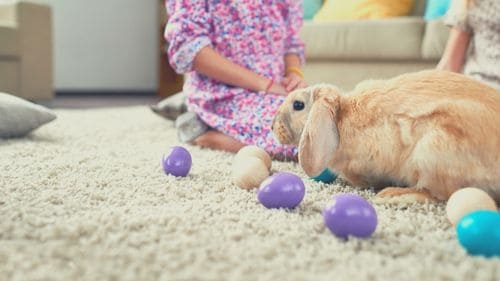
The diet of an adult rabbit, between 7 months and 5 years of age, consists mainly of hay and vegetables. Hay should be offered on an unlimited basis, or at least an amount equal to the rabbit’s body size each day.
Timothy and oat hay are considered the best due to their low calorie and calcium content. Alfalfa hay, which is made from lucerne rather than grass, isn’t recommended for adults due to its high calcium and protein content.
Timothy hay-based pellets are a good way to get extra fiber into your rabbit. You can offer 1/4 to 1/2 cup per 5lbs body weight.
You can provide around 2-3 cups of vegetables per 5lbs body weight, but decrease this amount if you notice your rabbit isn’t eating enough hay.
Rabbit pellets and fresh fruits are decreased with age, to avoid diarrhea or weight gain. In general, you can offer fruits once or twice a week, provided your rabbit isn’t overweight and not sensitive to diarrhea.
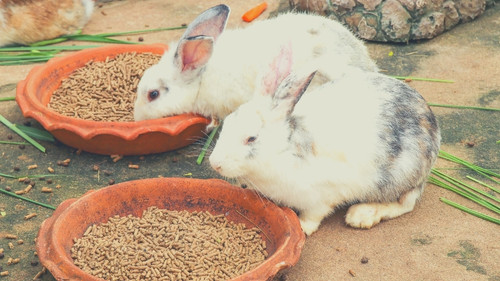
Senior rabbits over the age of 5, who are still healthy and active, can continue with their normal diet. However, if they are frail or losing weight, you can increase their intake of rabbit pellets. Be sure to rotate the vegetable options you offer to provide a range of vitamins.
Diet for Young Rabbits or Kittens
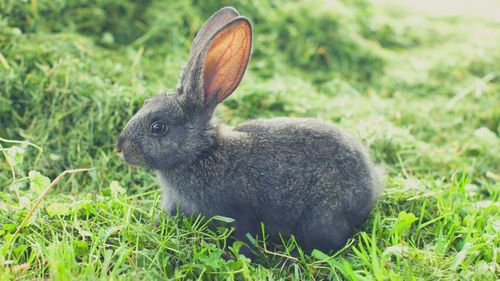
Rabbits under the age of 7 months have different nutritional needs than adults, and so it’s important to feed them appropriately.
Baby rabbits, or kittens, are extremely sensitive and should remain with their mothers for a minimum of 8 weeks before complete weaning. From birth to three weeks, kittens depend entirely on their mother’s milk.
They may begin nibbling on solids between 2-3 weeks, and eat solids properly from 3-4 weeks of age. Rabbits’ digestive systems adjust from milk to solid food between 6-8 weeks.
At 3-7 weeks, bunnies should be fed alfalfa pellets and grass hay while continuing with their mother’s milk. Introduce vegetables between 4-5 months, one at a time and in small quantities, keeping them at 1/2 oz. Start with leafy greens and offer fruits later as treats.
Once they are no longer nursing from their mother, young rabbits should have a handful of rabbit pellets each day to cover their protein needs.
Due to their high sensitivity, younger rabbits are more susceptible to digestive problems, which can be fatal, so it’s important to maintain a consistent diet and environment to avoid stress.
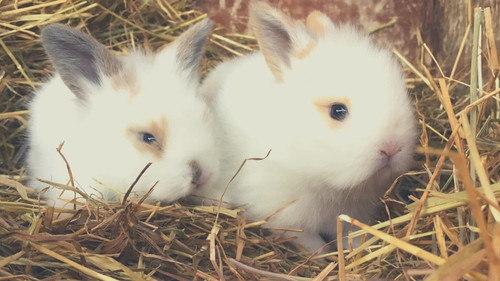
If you acquire a new baby rabbit, ask about its previous diet and feed them the same while they adjust to their new home. If no history is provided, it is safe to begin with hay and water.
A young rabbit’s ideal diet is similar to that for adults, but there are some extra considerations. Alfalfa hay is preferable for young rabbits since it’s rich in proteins and calcium to facilitate their growth. Gradually transition to grass hay as they get older.
Foods that Rabbits Can Eat and Their Benefits
Apart from a hay-rich diet, rabbits enjoy fresh fruits and vegetables. An assorted diet supplies necessary nutrients and keeps your bunny happy.
This table shows the foods that are often fed to pet rabbits, and whether I recommend you let a rabbit eat them.
| Popular foods | Rating |
|---|---|
| Grass hay | Perfect. Should be freely available and make up at least 80% of the diet. |
| Leafy greens (low in oxalic acid): carrot tops, kale, cabbage, Brussel sprouts, romaine lettuce, dandelion greens, bok choy, cucumber leaves, etc. | Good. Can make up 10-15% of the daily diet. |
| Non-leafy vegetables e.g. carrots, squash, red peppers, etc. | Feed in moderation, less than 10% of the diet, due to high starches and sugars. |
| High-quality rabbit pellets | Feed in moderation, around 5% of the diet, reduce if overweight. |
| Leafy greens (rich in oxalic acid): mustard greens, spinach, beet greens, sprouts, etc. | Feed in moderation, less than 5% of the diet, due to high oxalic acid. |
| Fruits e.g. apples, melon, bananas, etc. | Feed sparingly, less than 5% of the diet, due to sugar content. Stop if overweight. |
| Muesli-style foods | Avoid. Encourage selective feeding, can cause teeth and digestive problems. |
| Dairy products | Avoid. Cause weight gain and tooth decay. |
| Potato and potato tops | Avoid. Very high starch and can disturb digestive balance. |
| Rhubarb | Avoid. Irritant and can be poisonous. |
| Tomato leaves | Avoid. Make rabbits sick and can be poisonous. |
| Onions, garlic, and related plants | Avoid. Can damage blood cells. |
Let’s look at a few of these categories in more detail.
Grass and Hay
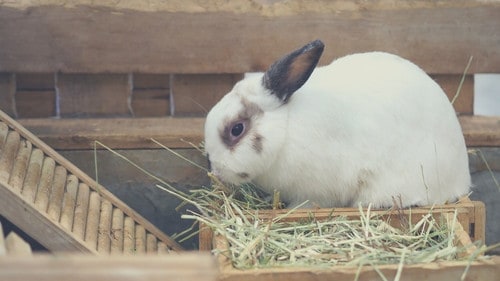
Grass or hay is the baseline of a rabbit’s nutrition and should make up 80-85% of the diet. Wild rabbits consume lots of grass to meet their daily needs. However, it’s difficult for domestic rabbits to access adequate quantities of grass to meet their needs, hence the need to substitute it with hay.
Hay is rich in calcium, protein, vitamins A and D, and other nutrients. Hay also provides fiber, which prevents diarrhea, hairballs, and obesity. It promotes a healthy gastrointestinal tract and aids in digestion.
Hay also helps wear down a rabbit’s continuously growing teeth and keeps the incisors healthy.
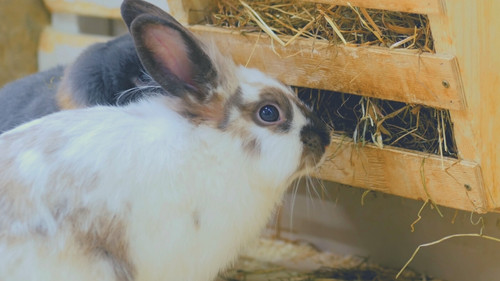
Fresh hay is a good food to start with, since it’s gentle on a rabbit’s stomach and doesn’t cause sensitivities; it also has a nice smell and high palatability.
Hay is considered fresh hay if harvested less than 8 weeks ago. Place hay at your bunny’s favorite spot and on one end of the litter box for it to chew as it poops.
Make sure the hay you feed your rabbit is free from excessive dust and stored in a dry location away from direct sunlight. It shouldn’t be sealed in an airtight container, since that may promote the growth of deadly mold toxins. Also, be sure that the hay is completely dry to avoid it going moldy.
Alfalfa Hay
Alfalfa is made from lucerne, which is a legume rather than a grass. It is very rich in calories and proteins, more than average domestic rabbits need.
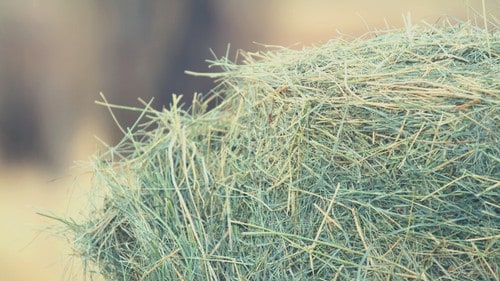
Alfalfa is thus a good feed for frail or underweight bunnies, babies, and young rabbits, who should be allowed to feed on it freely. However, it isn’t recommended for adult rabbits since it may cause unnecessary weight gain.
Alfalfa contains around three times as much calcium as grass hay, so it shouldn’t be fed to bunnies with calcium-related health issues such as bladder crystals.
Oat Hay
Oat hay is harvested before the oat head matures into a seed, leaving crunchy husks for your rabbit to enjoy. It is rich in fiber, vitamins, and minerals but low in protein. It can be fed alone or blended with other grass hays.
Fresh Greens
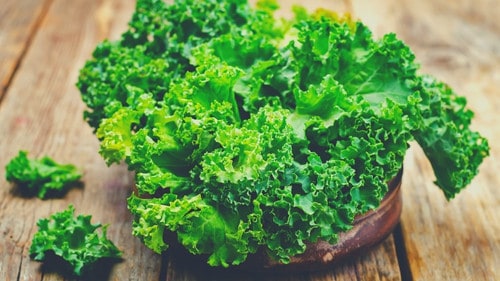
Fresh leafy greens are essential in your rabbit’s diet since they are a great source of nutrients, and offer a variety of textures and tastes. They also add moisture to the diet. The fresh foods given to bunnies should consist of 75% leafy greens.
Feed your rabbit greens such as cabbage, kale, parsley, bok choy, and mustard greens. Dandelions are a particular favorite of many rabbits! If you are buying greens, try to buy organic produce whenever possible.
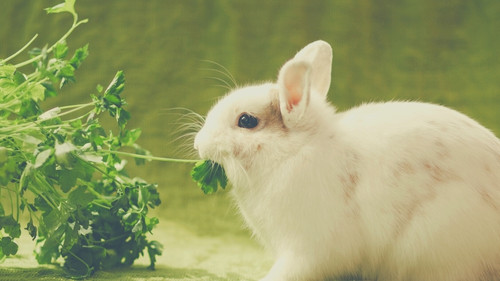
If collecting from the yard or wild land, only pick them from a pesticide-free area. Wash all fresh foods, irrespective of their sources, before feeding them to your pet rabbit.
Mustard greens, beet greens and spinach are rich in oxalic acid, while other types like cabbage, bok choy and carrot tops have low amounts or none.
Oxalic acid can cause urinary crystals or stones, so these shouldn’t be fed in large quantities. However, you don’t need to exclude these nutritious foods from your bunny’s diet: instead, offer them in small portions, mixed with other leafy greens.
Avoid giving the same greens every day to prevent boredom and increase the variety of nutrients.
Note that hay provides high levels of vitamin A, and unlike humans, rabbits produce their own vitamin C when fed on a healthy diet. So you don’t need to focus too much on a vegetable’s vitamin A or C content.
Other Fresh Vegetables
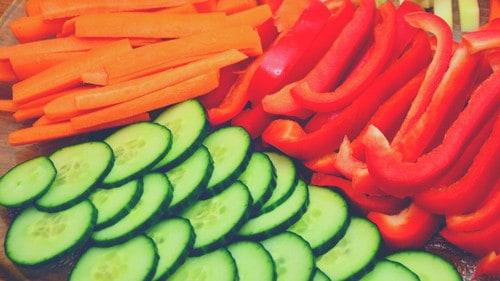
Other fresh foods may include non-leafy greens, salad vegetables like red peppers, and root vegetables. Although these vegetables can be nutritious, you should give them in small portions since most are high in starch and sugar. Starch and sugar alter a bunny’s cecum pH, resulting in serious gastrointestinal problems.
Some veggies carry specific red flags for rabbits:
- Carrots – should be fed sparingly as treats due to their high sugar content.
- Lettuce – contrary to what we might learn from the classic Peter Rabbit stories, lettuce is not a great food for rabbits. Iceberg lettuce contains lactucarium, which is harmful in large quantities. Light-colored varieties are too watery, with meager nutritional value, and have the potential to trigger diarrhea. You should avoid feeding them to rabbits. However, you can feed your rabbit darker, leafy, and fibrous varieties such as romaine lettuce. Introduce them gradually to avoid stomach upsets.
- Cucumber – it’s tasty, but its high water content isn’t rabbit-friendly. Cucumber can cause indigestion and diarrhea, so give small amounts once a week as a treat only.
- Onions – avoid foods in the onion family since they can cause blood abnormalities.
Dried Rabbit Food
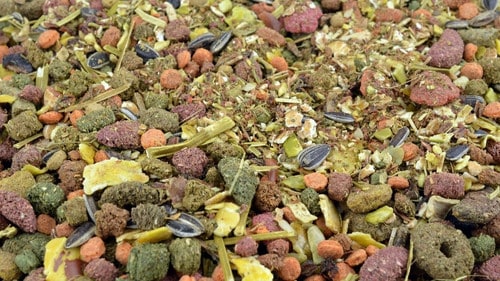
While commercial diets may be promoted by manufacturers and pet stores, they should really make up a very small proportion of the rabbit’s diet.
In fact, if you are providing a good balance of hay and fresh greens, you may not need to offer a commercial diet at all.
If you do want to offer some rabbit food, it should make up just 5% of the diet. Look for high-quality rabbit pellets rather than muesli-style foods, as they offer a better balance of nutrition.
The muesli-style varieties encourage selective eating, where the rabbit eats certain components, like dried corn, but leaves other parts.
How to Change a Rabbit’s Diet
Consistency is a great factor in rabbits’ well-being. If you want to get the health benefits of changing your bunny’s diet, it’s important to do it the right way.
Not Too Fast
When changing a rabbit’s diet, don’t change too suddenly. Rabbits have sensitive digestive systems, and the quick introduction of new foods or inappropriate forage may upset the balance of digestive micro-flora, causing illness and even rabbit fatalities.
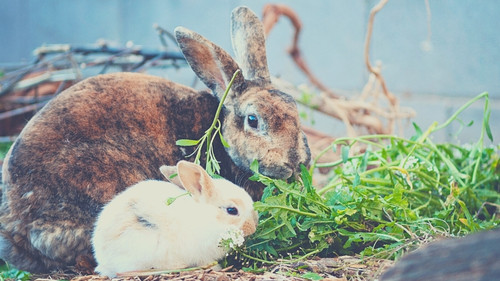
Make any changes gradually over 2-4 weeks. Begin by mixing small quantities of the new food with the current food. Gradually increase the new food’s amount as you decrease the old food daily until your bunny transitions fully. Watch for stomach upsets and stool changes, and halt if you notice any problems.
Probiotic
Rabbits depend heavily on their digestive bacteria, and these can come under shock when you change the diet. I recommend my clients give their rabbits a probiotic to support these gut bacteria during the change.
Equa Holistics and BeneBunny are both great brands that come in a powder form, which you can sprinkle onto your rabbit’s daily pellets or vegetables.
Part of a Healthy Lifestyle
A rabbit’s health isn’t only determined by its diet; you also need to provide the right environment for your pet to thrive. It is essential to provide at least 8 sq ft enclosure space with 24 sq ft exercise space where your bunny can run and play for 5 hrs daily.
Provide toys such as play balls, chew toys, and tunnel toys to keep them mentally engaged.
Frequently Asked Questions
What vegetables can rabbits eat?
Rabbits can eat many varieties of vegetables daily, including bok choy, endives, wheatgrass, carrot tops, and watercress. Give a mixture of different vegetables each day to make sure your rabbit gets the best vitamin and mineral combination.
Other vegetables that bunnies can eat sparingly (once or twice a week) include carrots, collard greens, clover, kale, and dandelion greens.
What fruits can rabbits eat?
Rabbits can eat fruits such as seeded apples and cherries, peaches, berries, watermelons, and pears. Fruits should be given once or twice a week at most, and limited to one or two tablespoons per 5lbs of body weight. If your rabbit is overweight or is prone to diarrhea, you can cut the fruits from their diet.
What do rabbits like to eat most?
Rabbits have a sweet tooth and love eating treats, fruits and vegetables. Be cautious about what you give to your bunny since some of its favorites aren’t healthy.
What human foods can bunnies eat?
Rabbits can eat most fruits and vegetables that humans do, but they should be in small quantities. Good examples include berries, apples, bell peppers, cilantro, celery, carrots, and kale. Avoid onions, potatoes and rhubarb.
Conclusion
A rabbit healthy diet should comprise mainly high-fiber foods such as grass and/or hay, fresh greens and vegetables, a few fruits, and a constant supply of fresh water. A young rabbit has more energy and growth requirements than an adult rabbit and thus requires high-calorie and protein-rich foods such as alfalfa hay and pellets.
Left on its own in the wild, a rabbit will eat a range of food items, but grass would be its main food supply. As a pet parent, providing a balanced diet can help keep your bunny healthy.


